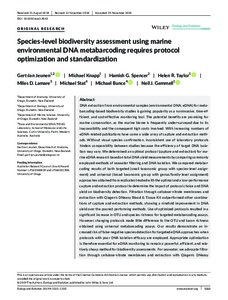| dc.contributor.author | Jeunen, Gert‐Jan | |
| dc.contributor.author | Knapp, Michael | |
| dc.contributor.author | Spencer, Hamish G. | |
| dc.contributor.author | Taylor, Helen R. | |
| dc.contributor.author | Lamare, Miles D. | |
| dc.contributor.author | Stat, Michael | |
| dc.contributor.author | Bunce, Michael | |
| dc.contributor.author | Gemmell, Neil J. | |
| dc.date.accessioned | 2020-03-04T20:48:25Z | |
| dc.date.available | 2020-03-04T20:48:25Z | |
| dc.date.issued | 2019 | |
| dc.identifier.citation | Jeunen, G‐J.; Knapp, M.; Spencer, H.G.; et al. (2019) Species‐level biodiversity assessment using marine
environmental DNA metabarcoding requires protocol optimization and standardization. Ecology and Evolution, 9, pp.1323-1335. DOI:. https://doi.org/10.1002/ece3.4843 | en_US |
| dc.identifier.uri | http://hdl.handle.net/11329/1227 | |
| dc.identifier.uri | http://dx.doi.org/10.25607/OBP-742 | |
| dc.description.abstract | DNA extraction from environmental samples (environmental DNA; eDNA) for metabarcoding‐based biodiversity studies is gaining popularity as a noninvasive, time‐efficient, and cost‐effective monitoring tool. The potential benefits are promising for
marine conservation, as the marine biome is frequently under‐surveyed due to its
inaccessibility and the consequent high costs involved. With increasing numbers of
eDNA‐related publications have come a wide array of capture and extraction methods. Without visual species confirmation, inconsistent use of laboratory protocols
hinders comparability between studies because the efficiency of target DNA isolation may vary. We determined an optimal protocol (capture and extraction) for marine eDNA research based on total DNA yield measurements by comparing commonly
employed methods of seawater filtering and DNA isolation. We compared metabarcoding results of both targeted (small taxonomic group with species‐level assignment) and universal (broad taxonomic group with genus/family‐level assignment)
approaches obtained from replicates treated with the optimal and a low‐performance
capture and extraction protocol to determine the impact of protocol choice and DNA
yield on biodiversity detection. Filtration through cellulose‐nitrate membranes and
extraction with Qiagen's DNeasy Blood & Tissue Kit outperformed other combinations of capture and extraction methods, showing a ninefold improvement in DNA
yield over the poorest performing methods. Use of optimized protocols resulted in a
significant increase in OTU and species richness for targeted metabarcoding assays.
However, changing protocols made little difference to the OTU and taxon richness
obtained using universal metabarcoding assays. Our results demonstrate an increased risk of false‐negative species detection for targeted eDNA approaches when
protocols with poor DNA isolation efficacy are employed. Appropriate optimization
is therefore essential for eDNA monitoring to remain a powerful, efficient, and relatively cheap method for biodiversity assessments. For seawater, we advocate filtration through cellulose‐nitrate membranes and extraction with Qiagen's DNeasy Blood & Tissue Kit or phenol‐chloroform‐isoamyl for successful implementation of eDNA multi‐marker metabarcoding surveys. | en_US |
| dc.language.iso | en | en_US |
| dc.rights | Attribution 4.0 International | * |
| dc.rights.uri | http://creativecommons.org/licenses/by/4.0/ | * |
| dc.subject.other | Biodiversity assessment | en_US |
| dc.subject.other | eDNA | en_US |
| dc.subject.other | Extraction | en_US |
| dc.subject.other | Filtration | en_US |
| dc.subject.other | Metabarcoding | en_US |
| dc.title | Species‐level biodiversity assessment using marine environmental DNA metabarcoding requires protocol optimization and standardization. | en_US |
| dc.type | Journal Contribution | en_US |
| dc.description.refereed | Refereed | en_US |
| dc.format.pagerange | pp.1323–1335 | en_US |
| dc.identifier.doi | https://doi.org/10.1002/ece3.4843 | |
| dc.subject.parameterDiscipline | Parameter Discipline::Biological oceanography::Other biological measurements | en_US |
| dc.subject.parameterDiscipline | Parameter Discipline::Biological oceanography::Biota composition | en_US |
| dc.bibliographicCitation.title | Ecology and Evolution | en_US |
| dc.bibliographicCitation.volume | 9 | en_US |
| dc.description.sdg | 14.A | en_US |
| dc.description.bptype | Manual (incl. handbook, guide, cookbook etc) | en_US |
| obps.contact.contactname | Gert‐Jan Jeunen | |
| obps.contact.contactemail | gert-jan.jeunen@otago.ac.nz | |
| obps.resourceurl.publisher | https://onlinelibrary.wiley.com/doi/full/10.1002/ece3.4843 | en_US |
 Repository of community practices in Ocean Research, Applications and Data/Information Management
Repository of community practices in Ocean Research, Applications and Data/Information Management

